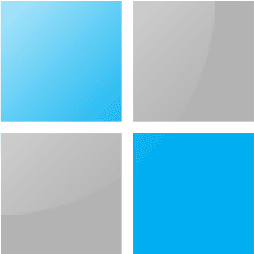Let’s say I have 3 monitors set up at home. But since doing video conferencing over RDP is still practically difficult, I’d prefer running Zoom or Teams along with some other apps outside the RDP session on one screen while running RDP on the remaining 2 screens in full-screen mode.
Possible? Yes, but need some tweaks.
First, let’s save a RDP connection with Full Screen setup that uses all monitors for remote session.

Right-click on the RDP icon > Open With, and choose Notepad from the list. That’s right. We are opening it in the text editor to make some changes.

The line you are looking at is called “selectedmonitors:s:x,y“. If you don’t see one, manually type it in.

Here is the tricky part. How do I find the monitor ID to use in this line? Let’s start with the following command-line to find out all the IDs registered with Remote Desktop Client.
mstsc /l

Pay attention to the coordinates inside the brackets. You can only use the monitors that are side-by-side listed.
For example, according to these position numbers, the correct layout of my monitors from left to right is 0, 2, and 1, not 0, 1, 2 as listed. So the only two options that would work is
selectedmonitors:s:0,2
which uses the left 2 monitors on my set up and leaves the very right one for video conferencing. Or
selectedmoniotrs:s:1,2
which uses the right 2 monitors and leaves the very left one out of the RDP session.
If you use 0, 1 in there, you will only get one screen of RDP session instead.
Once that gets out of the way, the rest works like a charm.

Thanks to Scott Hanselman’s tip that gives me the hope that would work.


That’s a great help, Kent 🙂
I do that but then rdc won’t open the file.
wondered why it wasn’t working for a second… you have a typo: selectedmoniotrs:s:1,2 (moniotors instead of monitors).
Great stuff!
Man this is so cool needed this for so long thank!
Just what I needed. Thanks!
I’ve been wanting to do this for years. Thank you so much Kent!
how do I use monitor 2 and 3 on mac remote desktop?
I don’t see an option for selectedmonitors in the notepad when I do that
This worked for me, but upon a subsequent reboot the monitor indexes changed! Had to fix it up again.
I wonder if something changed or if there are instances where the rdp file does not contain that property. In my case, the selectedmonitors property does not exist in the file. I am using Windows RemoteApps to make the RDP connection though so that probably is the culprit.
OMG! Thank you so much for posting this!
I have wanted a way to do this for years! I’ve looked in the past and always came to the conclusion that there was no way to do it. I don’t know what prompted me to search again today, but I did and the link to this page was the first search result displayed.
Your solution works like a charm.
Having my RDC connection to Work run full screen on my two main monitors while also having local stuff open on my laptop screen is SUCH an improvement! Up until now, I have always kept my laptop screen closed, because full screen RDC that included 2 big monitors and 1 small-ish laptop screen did not look or work right at all.
Thank you! Thank you! Thank you!
(I’m running Windows 10 Pro with the standard Remote Desktop app, if anyone is wondering what version of Windows is required for this)
Excellent! Thank you!
Works a treat. Thanks!!
What do ineed to click/type/do after i edit the notepad?
This is exactly what I have needed. Once the edits are done to the RDS shortcut, you launch the remote session and it’s only on those monitors that you selected. The other(s) can be used for local resources. Do you know if there is a way to have it switch the Main Display to local monitor temporarily during the remote session OR do I need to establish that manually?
Thanks!
You have a typo in your second graphic.
selectedmoniotrs:s:1,2
should be
selectedmonitors:s:1,2
We have use VNC for a number of years, it does all this natively and supports zoom so you can have the remote screens squashed on one local screen or spread across 3 or 4 local screens and still have local apps running in their own window.. Is this not possible in RDP without tweaking ?
“the correct layout of my monitors from left to right is 0, 2, and 1, not 0, 1, 2 as listed”
Not sure I understand, how do you know that?
MANY THANKS works rely awesome!!!
Excellent, thank you!
Although for some reason the mstsc /l looks like a 1 (one) to me, even though it’s supposed to be an L
Thank you – works perfect!
Using 0 and 1 for RDP and 2 for local computer/Teams 🙂
Thx!